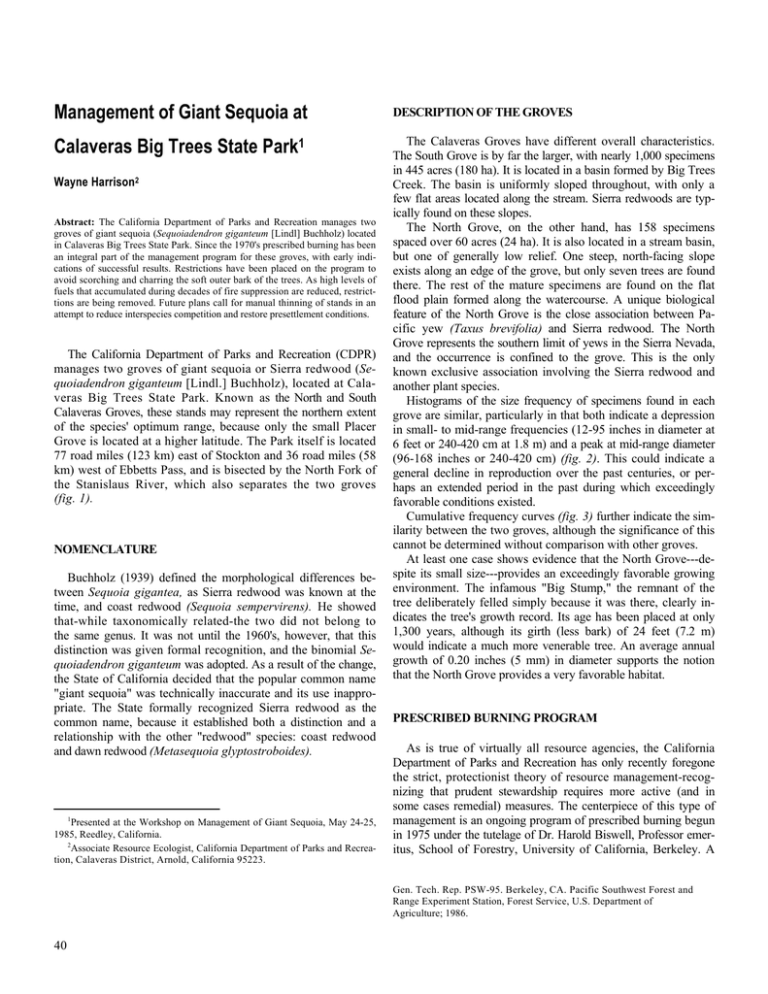Management of Giant Sequoia at Calaveras Big Trees State Park
advertisement

Management of Giant Sequoia at DESCRIPTION OF THE GROVES Calaveras Big Trees State Park1 The Calaveras Groves have different overall characteristics. The South Grove is by far the larger, with nearly 1,000 specimens in 445 acres (180 ha). It is located in a basin formed by Big Trees Creek. The basin is uniformly sloped throughout, with only a few flat areas located along the stream. Sierra redwoods are typ­ ically found on these slopes. The North Grove, on the other hand, has 158 specimens spaced over 60 acres (24 ha). It is also located in a stream basin, but one of generally low relief. One steep, north-facing slope exists along an edge of the grove, but only seven trees are found there. The rest of the mature specimens are found on the flat flood plain formed along the watercourse. A unique biological feature of the North Grove is the close association between Pa­ cific yew (Taxus brevifolia) and Sierra redwood. The North Grove represents the southern limit of yews in the Sierra Nevada, and the occurrence is confined to the grove. This is the only known exclusive association involving the Sierra redwood and another plant species. Histograms of the size frequency of specimens found in each grove are similar, particularly in that both indicate a depression in small- to mid-range frequencies (12-95 inches in diameter at 6 feet or 240-420 cm at 1.8 m) and a peak at mid-range diameter (96-168 inches or 240-420 cm) (fig. 2). This could indicate a general decline in reproduction over the past centuries, or perhaps an extended period in the past during which exceedingly favorable conditions existed. Cumulative frequency curves (fig. 3) further indicate the sim­ ilarity between the two groves, although the significance of this cannot be determined without comparison with other groves. At least one case shows evidence that the North Grove---de­ spite its small size---provides an exceedingly favorable growing environment. The infamous "Big Stump," the remnant of the tree deliberately felled simply because it was there, clearly in­ dicates the tree's growth record. Its age has been placed at only 1,300 years, although its girth (less bark) of 24 feet (7.2 m) would indicate a much more venerable tree. An average annual growth of 0.20 inches (5 mm) in diameter supports the notion that the North Grove provides a very favorable habitat. Wayne Harrison2 Abstract: The California Department of Parks and Recreation manages two groves of giant sequoia (Sequoiadendron giganteum [Lindl] Buchholz) located in Calaveras Big Trees State Park. Since the 1970's prescribed burning has been an integral part of the management program for these groves, with early indi­ cations of successful results. Restrictions have been placed on the program to avoid scorching and charring the soft outer bark of the trees. As high levels of fuels that accumulated during decades of fire suppression are reduced, restrict­ tions are being removed. Future plans call for manual thinning of stands in an attempt to reduce interspecies competition and restore presettlement conditions. The California Department of Parks and Recreation (CDPR) manages two groves of giant sequoia or Sierra redwood (Sequoiadendron giganteum [Lindl.] Buchholz), located at Cala­ veras Big Trees State Park. Known as the North and South Calaveras Groves, these stands may represent the northern extent of the species' optimum range, because only the small Placer Grove is located at a higher latitude. The Park itself is located 77 road miles (123 km) east of Stockton and 36 road miles (58 km) west of Ebbetts Pass, and is bisected by the North Fork of the Stanislaus River, which also separates the two groves (fig. 1). NOMENCLATURE Buchholz (1939) defined the morphological differences between Sequoia gigantea, as Sierra redwood was known at the time, and coast redwood (Sequoia sempervirens). He showed that-while taxonomically related-the two did not belong to the same genus. It was not until the 1960's, however, that this distinction was given formal recognition, and the binomial Sequoiadendron giganteum was adopted. As a result of the change, the State of California decided that the popular common name "giant sequoia" was technically inaccurate and its use inappro­ priate. The State formally recognized Sierra redwood as the common name, because it established both a distinction and a relationship with the other "redwood" species: coast redwood and dawn redwood (Metasequoia glyptostroboides). 1 Presented at the Workshop on Management of Giant Sequoia, May 24-25, 1985, Reedley, California. 2 Associate Resource Ecologist, California Department of Parks and Recrea­ tion, Calaveras District, Arnold, California 95223. PRESCRIBED BURNING PROGRAM As is true of virtually all resource agencies, the California Department of Parks and Recreation has only recently foregone the strict, protectionist theory of resource management-recog­ nizing that prudent stewardship requires more active (and in some cases remedial) measures. The centerpiece of this type of management is an ongoing program of prescribed burning begun in 1975 under the tutelage of Dr. Harold Biswell, Professor emer­ itus, School of Forestry, University of California, Berkeley. A Gen. Tech. Rep. PSW-95. Berkeley, CA. Pacific Southwest Forest and Range Experiment Station, Forest Service, U.S. Department of Agriculture; 1986. 40 Figure 1-Calaveras Big Trees State Park is located between Stockton and Ebbetts Pass. critical aspect of the burning program was that CDPR is not only a resource agency but a recreation agency as well. Moreover, the agency has an administratively close relationship with the public. For example, the CDPR has historically depended upon private organizations such as the Save-the-Redwoods League and the Sempervirens Club for the purchase of park property. In fact, the South Calaveras Grove was acquired in this manner. In a broader scope, a major portion of funding for CDPR comes from bond acts passed by the citizens of California. Therefore, the agency would be remiss if the views of the private sector were not considered in the planning processes. This public opin­ ion has affected the evolution and management of the prescribed burning program. When the issue of conducting burns in the South Grove was first raised, little concern was expressed over the desirability of such a program: The National Park Service (NPS), U.S. De­ partment of the Interior, had already well established its efficacy. Rather, the public was more concerned over the potentially un­ desirable visual impact that burning might have on the soft and ignitable outer bark of the Sierra redwood. As a means of mit­ igation, CDPR cut a line to mineral soil around each of the nearly 1,000 big trees in the South Grove. Other efforts designed to reduce visual and environmental impacts included keeping fire away from riparian zones and stream channels, protecting snags and raking around mountain dogwoods (Cornus nuttallii), which are susceptible to cambium damage from fire. To further complicate matters, unlike the NPS and the Forest Service, U.S. Department of Agriculture, CDPR is not its own fire control agency: all burns have to be conducted with the ap­ proval of the California Department of Forestry (CDF). In 1975, CDF was still divided over the question of prescribed burning. When CDPR requested a permit from CDF to start burning in the South Grove basin, the size of each burn was limited to only a few acres. Given the limited burning "windows" available in the spring and fall each year, burning the entire 1,250 acres (506 ha) of the Big Trees Creek basin would have been a monumental task. As CDPR showed that it could conduct burns safely, these acreage limitations were gradually eased, and finally removed. Similarly, some of the other restrictions already mentioned were dropped when the CDPR began burning in the North Grove in 1984. Only the restriction on charring the Sierra redwoods remained, and each tree was again raked before burning. When the North Grove burn is completed, this final mitigation measure can probably be dropped, and future burns in both groves may be conducted without special protection for the Sierra redwoods. These efforts were always considered to be primarily a response to the unusually high levels of forest fuels resulting from decades of fire suppression. Fires conducted under such conditions could be unnaturally intense and damaging. Now that fuel levels have been lowered, prescribed burns should be possible without pro­ ducing unacceptable charring of the trees. When the CDPR began burning in the South Grove in 1975, it was with intense concern over the potential disaster that could result if an uncontrolled wildfire should enter the' basin before 41 again, no pretreatment studies were conducted. Consequently, little substantive data is available on the condition of the grove immediately before these activities and their results can not be measured. BIOLOGICAL EVALUATION Figure 2-The frequency distribution of Sierra redwood is similar in the North and South Groves. the unnaturally high fuel loadings could be reduced. Because measured loadings range from 27 to 115 tons per acre (Agee and Biswell 1977), a summer wildfire in such fuels would be cata­ clysmic. For this reason, conducting prescribed burns in the South Grove was given the highest priority, at the expense of conducting an extensive and detailed preburn monitoring program. Furthermore, during the 5 years that burns were con­ ducted in the South Grove, whenever burning was not possible, crews manually thinned the understory throughout much of the grove. About 20,000 trees were removed in this manner. Once To rectify this lack of data (albeit belatedly) the CDPR initiated in 1985 a biological evaluation of the South Calaveras Grove and the surrounding basin. This study was designed to provide baseline data on a number of parameters, including growth rates, top condition, tree defects, and population characteristics for the Sierra redwood, plus composition and size characteristics for all other tree species. Permanent reference points and plots have been established so that follow-up studies will have a basis for comparison. It is unknown if this study will result in any man­ agement decision, but-at the least-it may be of interest to those who wish to know more about the community dynamics of the grove. The only previous systematic study of the South Grove pop­ ulation was conducted by the Forest Service in 1924. Oscar M. Evans mapped and measured each Sierra redwood with a di­ ameter of 12 inches (30 cm) or more, in both groves. The his­ tograms (fig. 2) and frequency curves (fig. 3) were derived from these data.3 They are the best sources of information available about the North and South Groves but are over 60 years old. This new study will at least identify changes over this period, although the methods and parameters are not similar to those of the Evans. The prime value of the biological evaluation will not be realized until the studies are replicated, or when other agencies conduct similar programs in the groves they manage. For instance, comparable information on growth rates between groves located at the northern, middle, and southern ranges would at least be interesting, and at the most could provide useful com­ parisons between different management schemes. I encourage such studies. FUTURE PLANS Finally, CDPR is planning an intensive management program in the North Grove. Using backward projection techniques de­ veloped by Bonnicksen and Stone (1978), we hope to develop a model of the presettlement characteristics of the grove, and manually thin the stand to reflect those conditions. This program is now in the planning stages, and work should begin during the 1986-87 fiscal year. REFERENCES Agee, James K.; Biswell, H.H. Fuels inventory: South Grove, Calaveras Big Trees State Park. 1977. Unpublished manuscript. Bonnicksen, Thomas M.; Stone, E.C. An analysis of vegetation management to restore the structure and function of presettlement giant sequoia-mixed con­ ifer forest mosaics. 1978. Unpublished manuscript. Buchholz, J.T. The generic segregation of the sequoias. Am. J. Bot. 26 (7): 535-538;1939. Figure 3-Cumulative frequency curves for Sierra redwood show that the North and South Grove apparently are similar. 42 3 Unpublished data on file, Calaveras District, California Department of Parks and Recreation, Arnold, California 95223.




